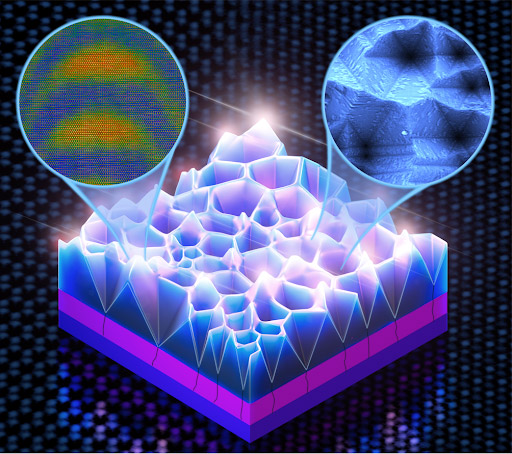Together with collaborators at the Massachusetts Institute of Technology (MIT), National University of Singapore (NUS) and Nanyang Technological University (NTU), researchers at the Low Energy Electronic Systems (LEES) Interdisciplinary Research Group (IRG) at Singapore-MIT Alliance for Research and Technology (SMART, a partnership between the Massachusetts Institute of Technology and the National Research Foundation of Singapore) have discovered a new method of generating long-wavelength (red, orange and yellow) light through the use of intrinsic defects in semiconducting materials, with potential applications as direct light emitters in commercial light sources and displays. This technology would be an improvement on existing methods (which use phosphors, for example) to convert one color of light to another.
Since first being fabricated over two decades ago in the 1990s, indium gallium nitride (InGaN) LEDs have evolved to become ever smaller while growing increasingly powerful, efficient and durable. InGaN LEDs are currently found across a myriad of industrial and consumer use cases (including signals & optical communication and data storage) and are critical in high-demand consumer applications such as solid-state lighting, television sets, laptops, mobile devices, augmented reality (AR) and virtual reality (VR) solutions.
Ever-growing demand for such electronic devices has driven over two decades of research into achieving higher optical output, reliability, longevity and versatility from semiconductors – leading to the need for LEDs that can emit different colours of light. Traditionally, InGaN material has been used in modern LEDs to generate purple and blue light, with aluminium gallium indium phosphide (AlGaInP) used to generate red, orange and yellow light. This is due to InGaN’s poor performance in the red and amber spectrum caused by a reduction in efficiency as a result of the higher levels of indium required.
In addition, such InGaN LEDs with considerably high indium concentrations remain difficult to manufacture using conventional semiconductor structures. As such, the realization of fully solid-state white-light-emitting devices – which require all three primary colors of light – remains an unattained goal.
Addressing these challenges, in the paper ‘Light-Emitting V-Pits: An Alternative Approach toward Luminescent Indium-Rich InGaN Quantum Dots’ (ACS Photonics, 2021 (8), issue 10, p2853), the SMART researchers describe a practical method to fabricate InGaN quantum dots with significantly higher indium concentration by making use of pre-existing defects in InGaN materials.
Picture: A new method of quantum dot fabrication has been demonstrated by making use of intrinsic defects in LED materials. Through the formation of pyramids, localized bright luminescence emanates from the pyramid apexes containing indium-rich quantum dots. Credits: Singapore-MIT Alliance for Research and Technology (SMART).
In this process, the coalescence of V-pits, which result from naturally existing dislocations in the material, directly forms indium-rich quantum dots, small islands of material that emit longer-wavelength light. By growing these structures on conventional silicon substrates, the need for patterning or unconventional substrates is further eliminated. The researchers also conducted high spatially resolved compositional mapping of the InGaN quantum dots, providing the first visual confirmation of their morphology.
In addition to the formation of quantum dots, the nucleation of stacking faults – another intrinsic crystal defect – further contributes to emissions of longer wavelengths.
“For years, researchers in the field have attempted to tackle the various challenges presented by inherent defects in InGaN quantum well structures,” notes the lead author, SMART graduate student Jing-Yang Chung. “In a novel approach, we instead engineered a nano-pit defect to achieve a platform for direct InGaN quantum dot growth. As a result, our work demonstrates the viability of using silicon substrates for new indium-rich structures which, along with addressing current challenges in the low efficiencies of long-wavelength InGaN light emitters, also alleviate the issue of expensive substrates.”
SMART says that, in this way, its discovery represents a step forward in overcoming InGaN’s reduced efficiency when producing red, orange and yellow light. In turn, this work could be instrumental in the future development of micro-LED arrays consisting of a single material.
“Our discovery also has implications for the environment,” says co-author Dr Silvija Gradečak, principal investigator at LEES. “For instance, this breakthrough could lead to a more rapid phasing out of non-solid-state lighting sources – such as incandescent bulbs – and even the current phosphor-coated blue InGaN LEDs with a fully solid-state color-mixing solution, in turn leading to a significant reduction in global energy consumption,” she adds.
“Our work could also have broader implications for the semiconductor and electronics industry, as the new method described here follows standard industry manufacturing procedures and can be widely adopted and implemented at scale,” says SMART CEO and LEES lead principal investigator Eugene Fitzgerald. “On a more macro level, apart from the potential ecological benefits that could result from InGaN-driven energy savings, our discovery will also contribute to the field’s continued research into and development of new efficient InGaN structures.”
The research was carried out by SMART and supported by the National Research Foundation (NRF) Singapore under its Campus for Research Excellence and Technological Enterprise (CREATE) program. For this paper, the LED structures were grown using SMART’s unique facilities and know-how, structural studies were conducted at NUS using atomically resolved electron microscopes, while nanoscale optical studies were conducted at MIT and NTU.












